Financial Control and Budgeting - Assignment
VerifiedAdded on 2020/12/30
|14
|4852
|389
AI Summary
Contribute Materials
Your contribution can guide someone’s learning journey. Share your
documents today.
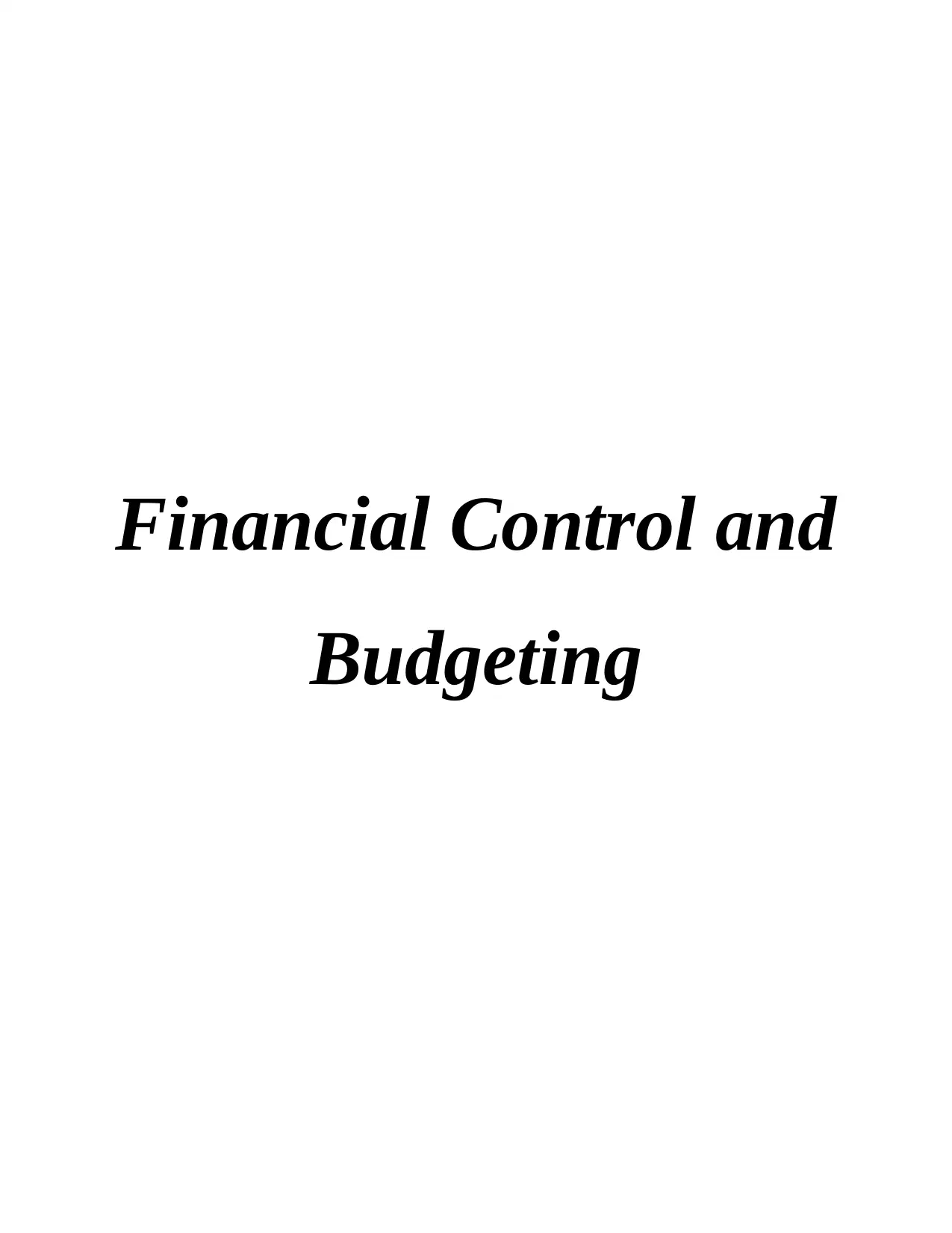
Financial Control and
Budgeting
Budgeting
Secure Best Marks with AI Grader
Need help grading? Try our AI Grader for instant feedback on your assignments.
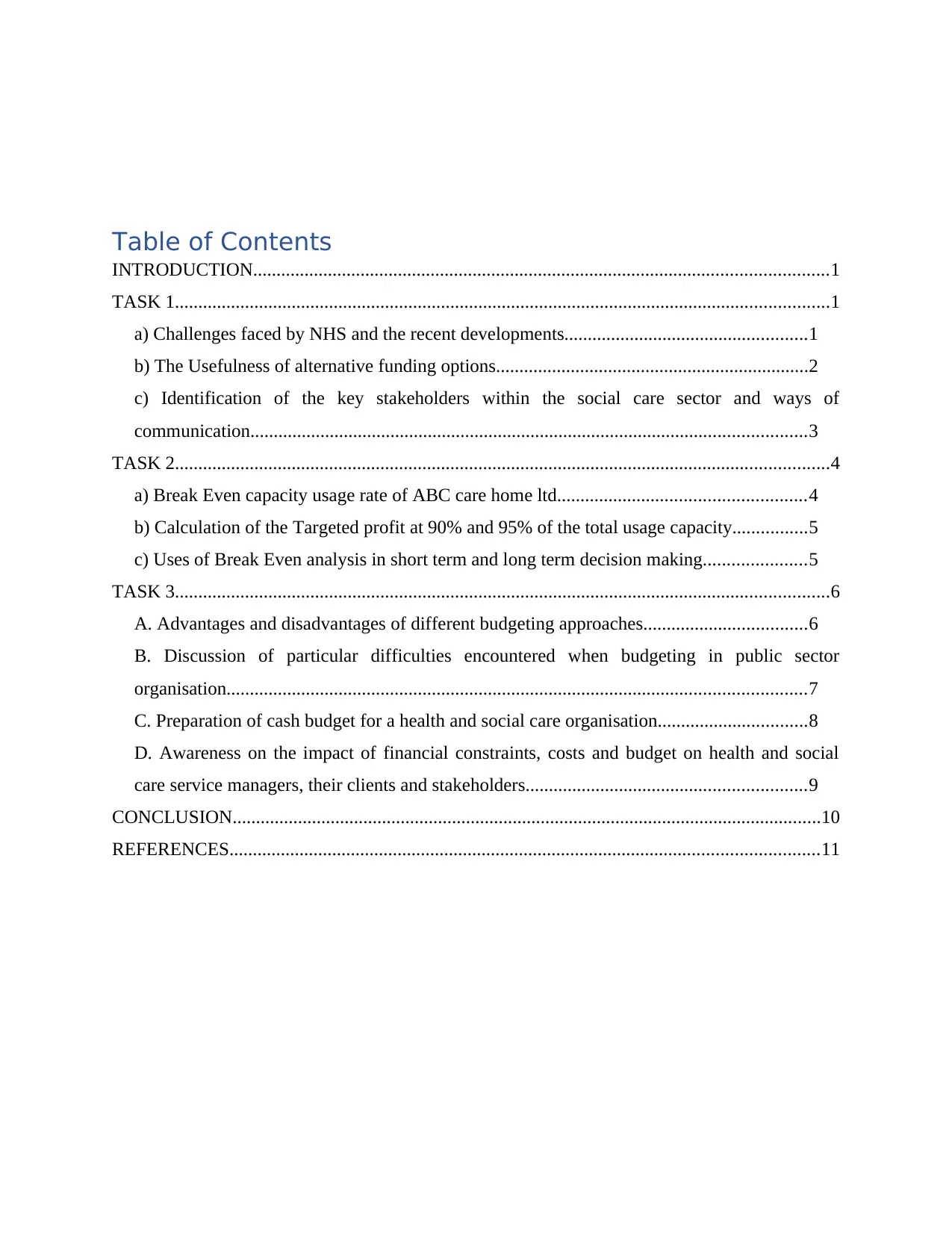
Table of Contents
INTRODUCTION...........................................................................................................................1
TASK 1............................................................................................................................................1
a) Challenges faced by NHS and the recent developments....................................................1
b) The Usefulness of alternative funding options...................................................................2
c) Identification of the key stakeholders within the social care sector and ways of
communication.......................................................................................................................3
TASK 2............................................................................................................................................4
a) Break Even capacity usage rate of ABC care home ltd.....................................................4
b) Calculation of the Targeted profit at 90% and 95% of the total usage capacity................5
c) Uses of Break Even analysis in short term and long term decision making......................5
TASK 3............................................................................................................................................6
A. Advantages and disadvantages of different budgeting approaches...................................6
B. Discussion of particular difficulties encountered when budgeting in public sector
organisation............................................................................................................................7
C. Preparation of cash budget for a health and social care organisation................................8
D. Awareness on the impact of financial constraints, costs and budget on health and social
care service managers, their clients and stakeholders............................................................9
CONCLUSION..............................................................................................................................10
REFERENCES..............................................................................................................................11
INTRODUCTION...........................................................................................................................1
TASK 1............................................................................................................................................1
a) Challenges faced by NHS and the recent developments....................................................1
b) The Usefulness of alternative funding options...................................................................2
c) Identification of the key stakeholders within the social care sector and ways of
communication.......................................................................................................................3
TASK 2............................................................................................................................................4
a) Break Even capacity usage rate of ABC care home ltd.....................................................4
b) Calculation of the Targeted profit at 90% and 95% of the total usage capacity................5
c) Uses of Break Even analysis in short term and long term decision making......................5
TASK 3............................................................................................................................................6
A. Advantages and disadvantages of different budgeting approaches...................................6
B. Discussion of particular difficulties encountered when budgeting in public sector
organisation............................................................................................................................7
C. Preparation of cash budget for a health and social care organisation................................8
D. Awareness on the impact of financial constraints, costs and budget on health and social
care service managers, their clients and stakeholders............................................................9
CONCLUSION..............................................................................................................................10
REFERENCES..............................................................................................................................11

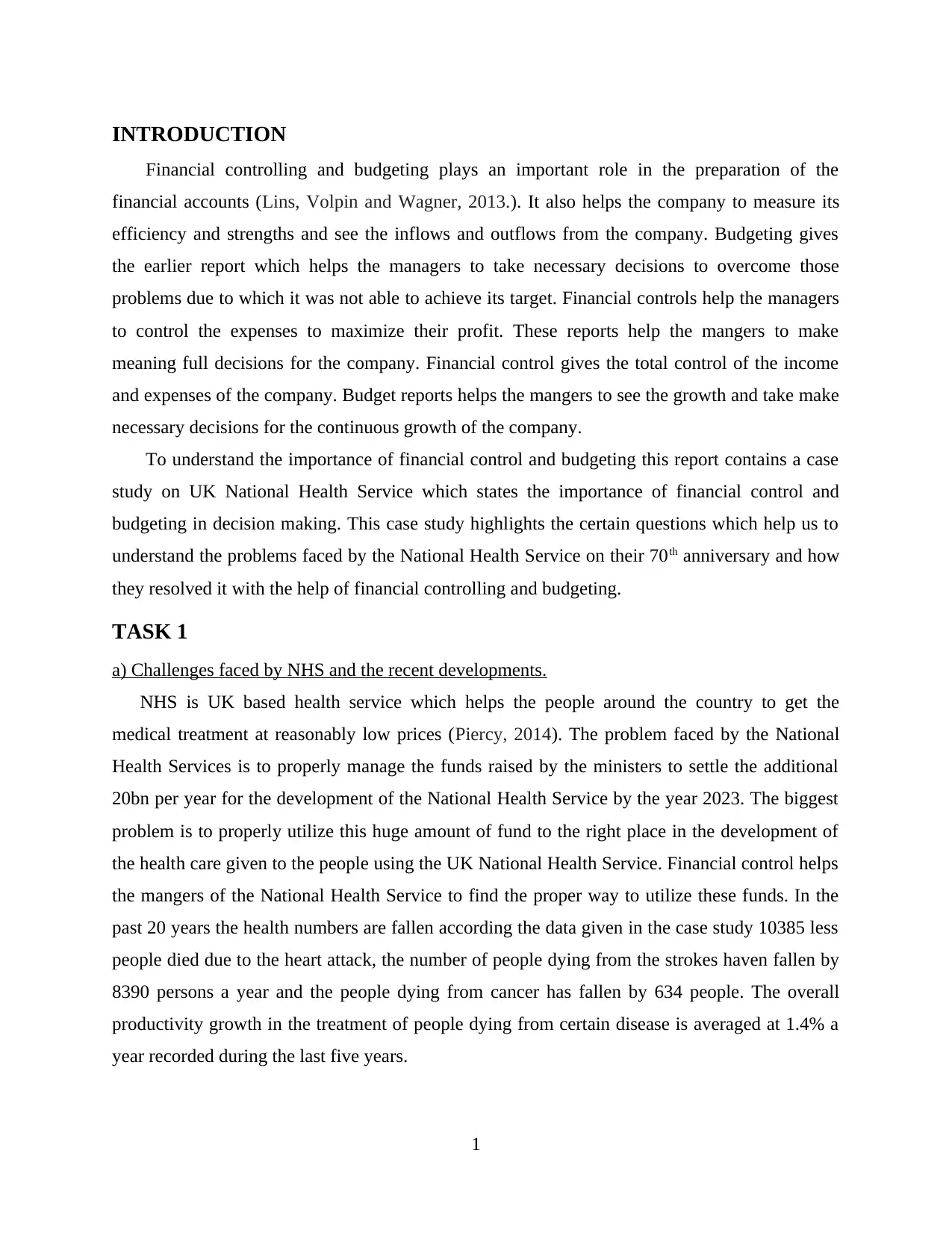
INTRODUCTION
Financial controlling and budgeting plays an important role in the preparation of the
financial accounts (Lins, Volpin and Wagner, 2013.). It also helps the company to measure its
efficiency and strengths and see the inflows and outflows from the company. Budgeting gives
the earlier report which helps the managers to take necessary decisions to overcome those
problems due to which it was not able to achieve its target. Financial controls help the managers
to control the expenses to maximize their profit. These reports help the mangers to make
meaning full decisions for the company. Financial control gives the total control of the income
and expenses of the company. Budget reports helps the mangers to see the growth and take make
necessary decisions for the continuous growth of the company.
To understand the importance of financial control and budgeting this report contains a case
study on UK National Health Service which states the importance of financial control and
budgeting in decision making. This case study highlights the certain questions which help us to
understand the problems faced by the National Health Service on their 70th anniversary and how
they resolved it with the help of financial controlling and budgeting.
TASK 1
a) Challenges faced by NHS and the recent developments.
NHS is UK based health service which helps the people around the country to get the
medical treatment at reasonably low prices (Piercy, 2014). The problem faced by the National
Health Services is to properly manage the funds raised by the ministers to settle the additional
20bn per year for the development of the National Health Service by the year 2023. The biggest
problem is to properly utilize this huge amount of fund to the right place in the development of
the health care given to the people using the UK National Health Service. Financial control helps
the mangers of the National Health Service to find the proper way to utilize these funds. In the
past 20 years the health numbers are fallen according the data given in the case study 10385 less
people died due to the heart attack, the number of people dying from the strokes haven fallen by
8390 persons a year and the people dying from cancer has fallen by 634 people. The overall
productivity growth in the treatment of people dying from certain disease is averaged at 1.4% a
year recorded during the last five years.
1
Financial controlling and budgeting plays an important role in the preparation of the
financial accounts (Lins, Volpin and Wagner, 2013.). It also helps the company to measure its
efficiency and strengths and see the inflows and outflows from the company. Budgeting gives
the earlier report which helps the managers to take necessary decisions to overcome those
problems due to which it was not able to achieve its target. Financial controls help the managers
to control the expenses to maximize their profit. These reports help the mangers to make
meaning full decisions for the company. Financial control gives the total control of the income
and expenses of the company. Budget reports helps the mangers to see the growth and take make
necessary decisions for the continuous growth of the company.
To understand the importance of financial control and budgeting this report contains a case
study on UK National Health Service which states the importance of financial control and
budgeting in decision making. This case study highlights the certain questions which help us to
understand the problems faced by the National Health Service on their 70th anniversary and how
they resolved it with the help of financial controlling and budgeting.
TASK 1
a) Challenges faced by NHS and the recent developments.
NHS is UK based health service which helps the people around the country to get the
medical treatment at reasonably low prices (Piercy, 2014). The problem faced by the National
Health Services is to properly manage the funds raised by the ministers to settle the additional
20bn per year for the development of the National Health Service by the year 2023. The biggest
problem is to properly utilize this huge amount of fund to the right place in the development of
the health care given to the people using the UK National Health Service. Financial control helps
the mangers of the National Health Service to find the proper way to utilize these funds. In the
past 20 years the health numbers are fallen according the data given in the case study 10385 less
people died due to the heart attack, the number of people dying from the strokes haven fallen by
8390 persons a year and the people dying from cancer has fallen by 634 people. The overall
productivity growth in the treatment of people dying from certain disease is averaged at 1.4% a
year recorded during the last five years.
1
Secure Best Marks with AI Grader
Need help grading? Try our AI Grader for instant feedback on your assignments.
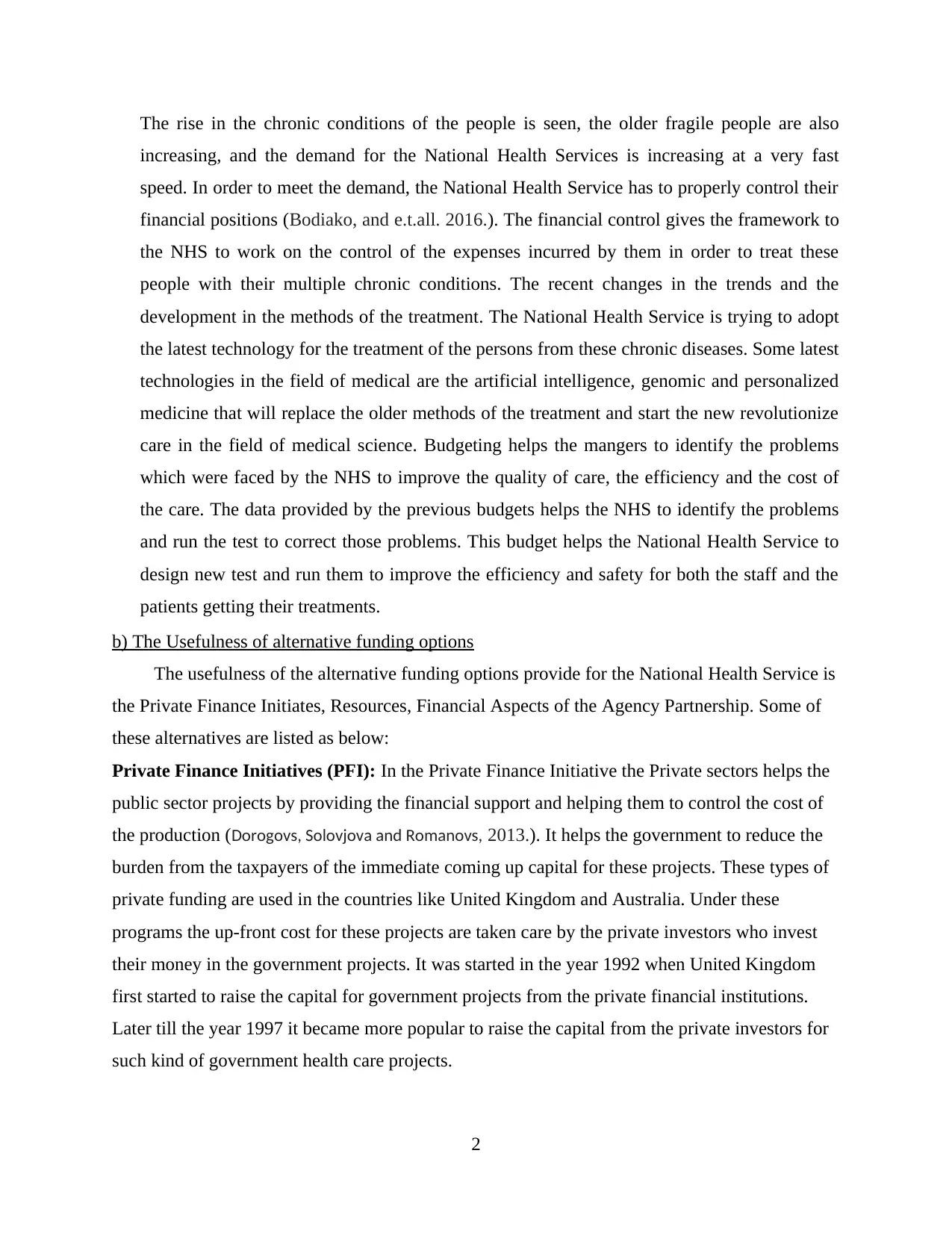
The rise in the chronic conditions of the people is seen, the older fragile people are also
increasing, and the demand for the National Health Services is increasing at a very fast
speed. In order to meet the demand, the National Health Service has to properly control their
financial positions (Bodiako, and e.t.all. 2016.). The financial control gives the framework to
the NHS to work on the control of the expenses incurred by them in order to treat these
people with their multiple chronic conditions. The recent changes in the trends and the
development in the methods of the treatment. The National Health Service is trying to adopt
the latest technology for the treatment of the persons from these chronic diseases. Some latest
technologies in the field of medical are the artificial intelligence, genomic and personalized
medicine that will replace the older methods of the treatment and start the new revolutionize
care in the field of medical science. Budgeting helps the mangers to identify the problems
which were faced by the NHS to improve the quality of care, the efficiency and the cost of
the care. The data provided by the previous budgets helps the NHS to identify the problems
and run the test to correct those problems. This budget helps the National Health Service to
design new test and run them to improve the efficiency and safety for both the staff and the
patients getting their treatments.
b) The Usefulness of alternative funding options
The usefulness of the alternative funding options provide for the National Health Service is
the Private Finance Initiates, Resources, Financial Aspects of the Agency Partnership. Some of
these alternatives are listed as below:
Private Finance Initiatives (PFI): In the Private Finance Initiative the Private sectors helps the
public sector projects by providing the financial support and helping them to control the cost of
the production (Dorogovs, Solovjova and Romanovs, 2013.). It helps the government to reduce the
burden from the taxpayers of the immediate coming up capital for these projects. These types of
private funding are used in the countries like United Kingdom and Australia. Under these
programs the up-front cost for these projects are taken care by the private investors who invest
their money in the government projects. It was started in the year 1992 when United Kingdom
first started to raise the capital for government projects from the private financial institutions.
Later till the year 1997 it became more popular to raise the capital from the private investors for
such kind of government health care projects.
2
increasing, and the demand for the National Health Services is increasing at a very fast
speed. In order to meet the demand, the National Health Service has to properly control their
financial positions (Bodiako, and e.t.all. 2016.). The financial control gives the framework to
the NHS to work on the control of the expenses incurred by them in order to treat these
people with their multiple chronic conditions. The recent changes in the trends and the
development in the methods of the treatment. The National Health Service is trying to adopt
the latest technology for the treatment of the persons from these chronic diseases. Some latest
technologies in the field of medical are the artificial intelligence, genomic and personalized
medicine that will replace the older methods of the treatment and start the new revolutionize
care in the field of medical science. Budgeting helps the mangers to identify the problems
which were faced by the NHS to improve the quality of care, the efficiency and the cost of
the care. The data provided by the previous budgets helps the NHS to identify the problems
and run the test to correct those problems. This budget helps the National Health Service to
design new test and run them to improve the efficiency and safety for both the staff and the
patients getting their treatments.
b) The Usefulness of alternative funding options
The usefulness of the alternative funding options provide for the National Health Service is
the Private Finance Initiates, Resources, Financial Aspects of the Agency Partnership. Some of
these alternatives are listed as below:
Private Finance Initiatives (PFI): In the Private Finance Initiative the Private sectors helps the
public sector projects by providing the financial support and helping them to control the cost of
the production (Dorogovs, Solovjova and Romanovs, 2013.). It helps the government to reduce the
burden from the taxpayers of the immediate coming up capital for these projects. These types of
private funding are used in the countries like United Kingdom and Australia. Under these
programs the up-front cost for these projects are taken care by the private investors who invest
their money in the government projects. It was started in the year 1992 when United Kingdom
first started to raise the capital for government projects from the private financial institutions.
Later till the year 1997 it became more popular to raise the capital from the private investors for
such kind of government health care projects.
2
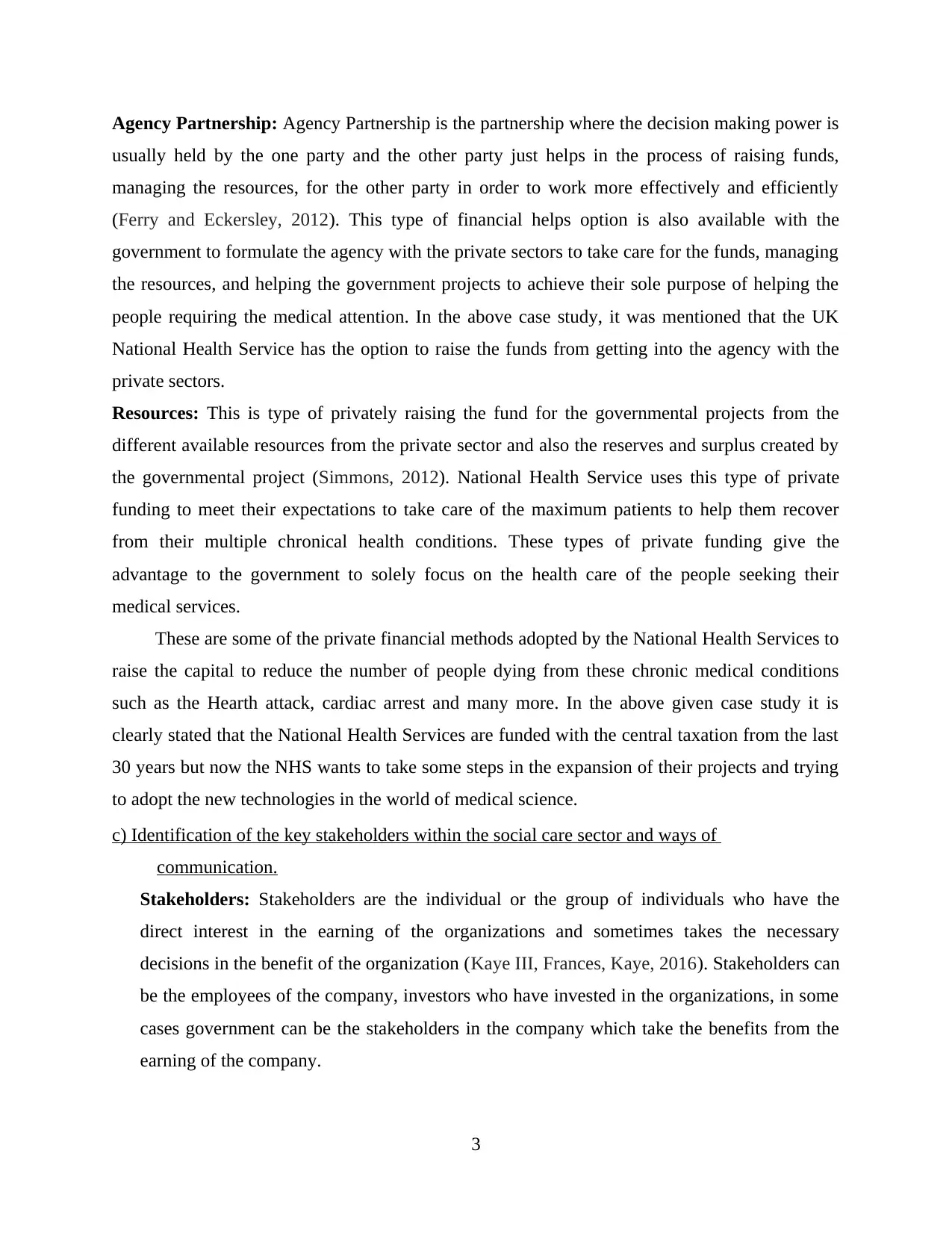
Agency Partnership: Agency Partnership is the partnership where the decision making power is
usually held by the one party and the other party just helps in the process of raising funds,
managing the resources, for the other party in order to work more effectively and efficiently
(Ferry and Eckersley, 2012). This type of financial helps option is also available with the
government to formulate the agency with the private sectors to take care for the funds, managing
the resources, and helping the government projects to achieve their sole purpose of helping the
people requiring the medical attention. In the above case study, it was mentioned that the UK
National Health Service has the option to raise the funds from getting into the agency with the
private sectors.
Resources: This is type of privately raising the fund for the governmental projects from the
different available resources from the private sector and also the reserves and surplus created by
the governmental project (Simmons, 2012). National Health Service uses this type of private
funding to meet their expectations to take care of the maximum patients to help them recover
from their multiple chronical health conditions. These types of private funding give the
advantage to the government to solely focus on the health care of the people seeking their
medical services.
These are some of the private financial methods adopted by the National Health Services to
raise the capital to reduce the number of people dying from these chronic medical conditions
such as the Hearth attack, cardiac arrest and many more. In the above given case study it is
clearly stated that the National Health Services are funded with the central taxation from the last
30 years but now the NHS wants to take some steps in the expansion of their projects and trying
to adopt the new technologies in the world of medical science.
c) Identification of the key stakeholders within the social care sector and ways of
communication.
Stakeholders: Stakeholders are the individual or the group of individuals who have the
direct interest in the earning of the organizations and sometimes takes the necessary
decisions in the benefit of the organization (Kaye III, Frances, Kaye, 2016). Stakeholders can
be the employees of the company, investors who have invested in the organizations, in some
cases government can be the stakeholders in the company which take the benefits from the
earning of the company.
3
usually held by the one party and the other party just helps in the process of raising funds,
managing the resources, for the other party in order to work more effectively and efficiently
(Ferry and Eckersley, 2012). This type of financial helps option is also available with the
government to formulate the agency with the private sectors to take care for the funds, managing
the resources, and helping the government projects to achieve their sole purpose of helping the
people requiring the medical attention. In the above case study, it was mentioned that the UK
National Health Service has the option to raise the funds from getting into the agency with the
private sectors.
Resources: This is type of privately raising the fund for the governmental projects from the
different available resources from the private sector and also the reserves and surplus created by
the governmental project (Simmons, 2012). National Health Service uses this type of private
funding to meet their expectations to take care of the maximum patients to help them recover
from their multiple chronical health conditions. These types of private funding give the
advantage to the government to solely focus on the health care of the people seeking their
medical services.
These are some of the private financial methods adopted by the National Health Services to
raise the capital to reduce the number of people dying from these chronic medical conditions
such as the Hearth attack, cardiac arrest and many more. In the above given case study it is
clearly stated that the National Health Services are funded with the central taxation from the last
30 years but now the NHS wants to take some steps in the expansion of their projects and trying
to adopt the new technologies in the world of medical science.
c) Identification of the key stakeholders within the social care sector and ways of
communication.
Stakeholders: Stakeholders are the individual or the group of individuals who have the
direct interest in the earning of the organizations and sometimes takes the necessary
decisions in the benefit of the organization (Kaye III, Frances, Kaye, 2016). Stakeholders can
be the employees of the company, investors who have invested in the organizations, in some
cases government can be the stakeholders in the company which take the benefits from the
earning of the company.
3
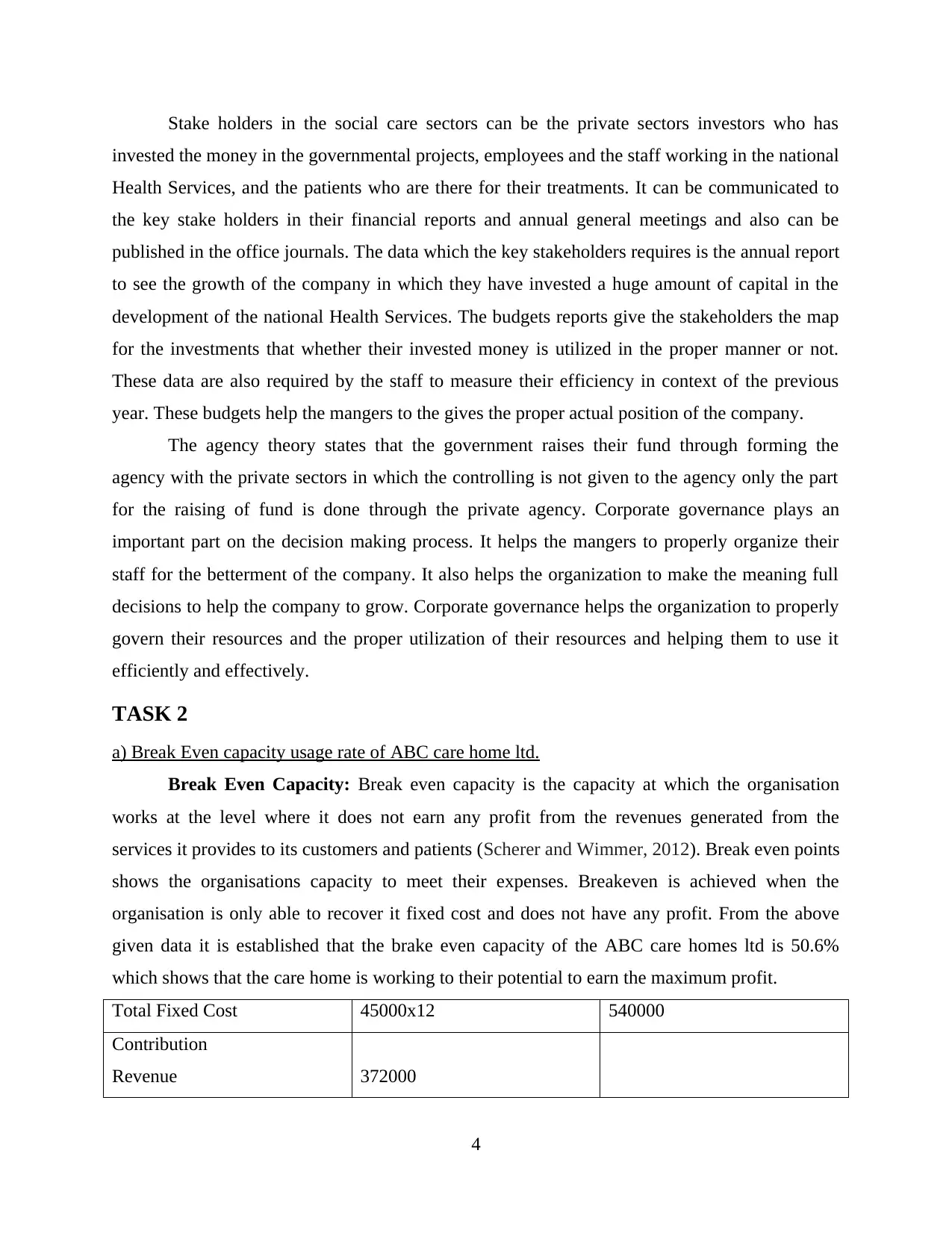
Stake holders in the social care sectors can be the private sectors investors who has
invested the money in the governmental projects, employees and the staff working in the national
Health Services, and the patients who are there for their treatments. It can be communicated to
the key stake holders in their financial reports and annual general meetings and also can be
published in the office journals. The data which the key stakeholders requires is the annual report
to see the growth of the company in which they have invested a huge amount of capital in the
development of the national Health Services. The budgets reports give the stakeholders the map
for the investments that whether their invested money is utilized in the proper manner or not.
These data are also required by the staff to measure their efficiency in context of the previous
year. These budgets help the mangers to the gives the proper actual position of the company.
The agency theory states that the government raises their fund through forming the
agency with the private sectors in which the controlling is not given to the agency only the part
for the raising of fund is done through the private agency. Corporate governance plays an
important part on the decision making process. It helps the mangers to properly organize their
staff for the betterment of the company. It also helps the organization to make the meaning full
decisions to help the company to grow. Corporate governance helps the organization to properly
govern their resources and the proper utilization of their resources and helping them to use it
efficiently and effectively.
TASK 2
a) Break Even capacity usage rate of ABC care home ltd.
Break Even Capacity: Break even capacity is the capacity at which the organisation
works at the level where it does not earn any profit from the revenues generated from the
services it provides to its customers and patients (Scherer and Wimmer, 2012). Break even points
shows the organisations capacity to meet their expenses. Breakeven is achieved when the
organisation is only able to recover it fixed cost and does not have any profit. From the above
given data it is established that the brake even capacity of the ABC care homes ltd is 50.6%
which shows that the care home is working to their potential to earn the maximum profit.
Total Fixed Cost 45000x12 540000
Contribution
Revenue 372000
4
invested the money in the governmental projects, employees and the staff working in the national
Health Services, and the patients who are there for their treatments. It can be communicated to
the key stake holders in their financial reports and annual general meetings and also can be
published in the office journals. The data which the key stakeholders requires is the annual report
to see the growth of the company in which they have invested a huge amount of capital in the
development of the national Health Services. The budgets reports give the stakeholders the map
for the investments that whether their invested money is utilized in the proper manner or not.
These data are also required by the staff to measure their efficiency in context of the previous
year. These budgets help the mangers to the gives the proper actual position of the company.
The agency theory states that the government raises their fund through forming the
agency with the private sectors in which the controlling is not given to the agency only the part
for the raising of fund is done through the private agency. Corporate governance plays an
important part on the decision making process. It helps the mangers to properly organize their
staff for the betterment of the company. It also helps the organization to make the meaning full
decisions to help the company to grow. Corporate governance helps the organization to properly
govern their resources and the proper utilization of their resources and helping them to use it
efficiently and effectively.
TASK 2
a) Break Even capacity usage rate of ABC care home ltd.
Break Even Capacity: Break even capacity is the capacity at which the organisation
works at the level where it does not earn any profit from the revenues generated from the
services it provides to its customers and patients (Scherer and Wimmer, 2012). Break even points
shows the organisations capacity to meet their expenses. Breakeven is achieved when the
organisation is only able to recover it fixed cost and does not have any profit. From the above
given data it is established that the brake even capacity of the ABC care homes ltd is 50.6%
which shows that the care home is working to their potential to earn the maximum profit.
Total Fixed Cost 45000x12 540000
Contribution
Revenue 372000
4
Paraphrase This Document
Need a fresh take? Get an instant paraphrase of this document with our AI Paraphraser
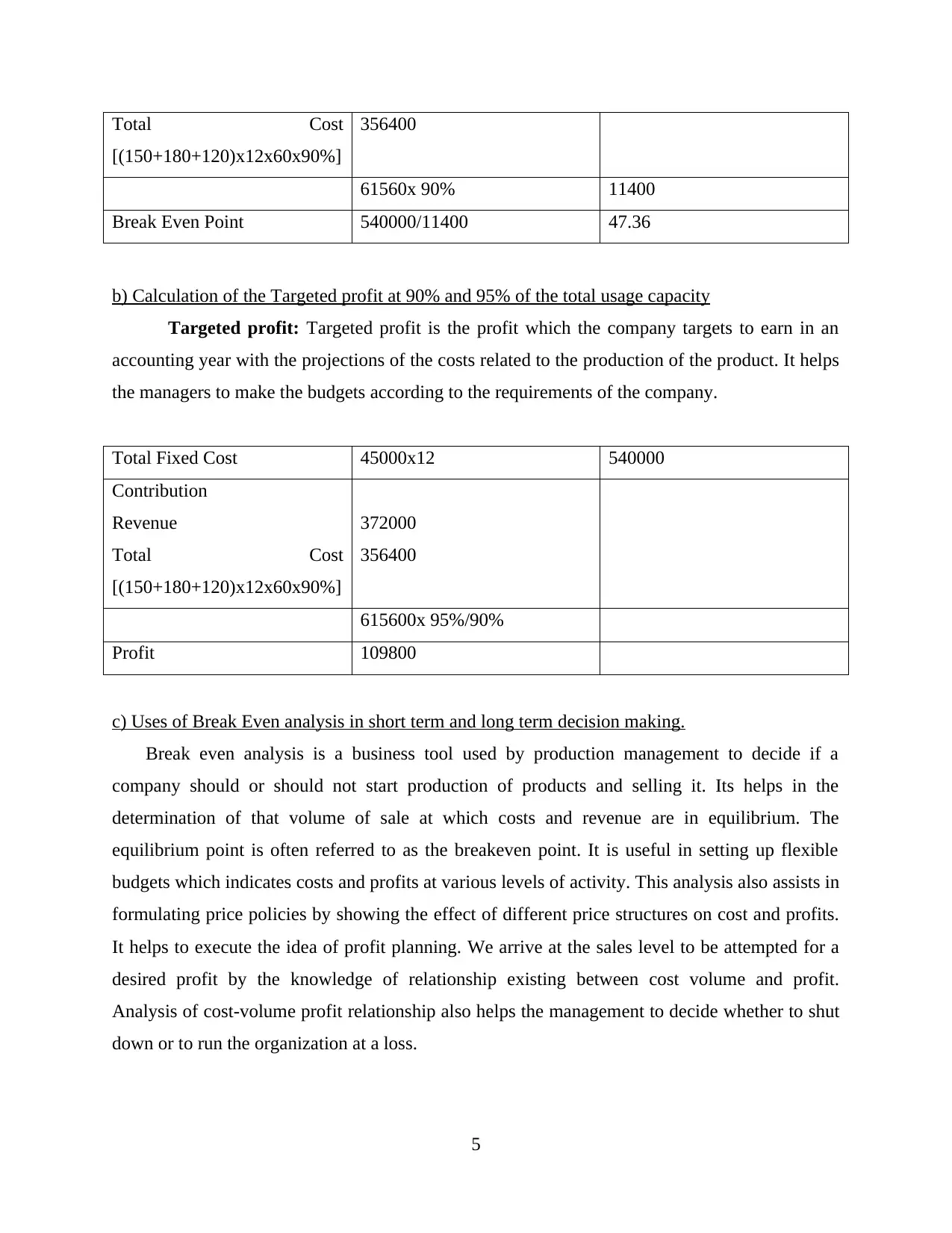
Total Cost
[(150+180+120)x12x60x90%]
356400
61560x 90% 11400
Break Even Point 540000/11400 47.36
b) Calculation of the Targeted profit at 90% and 95% of the total usage capacity
Targeted profit: Targeted profit is the profit which the company targets to earn in an
accounting year with the projections of the costs related to the production of the product. It helps
the managers to make the budgets according to the requirements of the company.
Total Fixed Cost 45000x12 540000
Contribution
Revenue
Total Cost
[(150+180+120)x12x60x90%]
372000
356400
615600x 95%/90%
Profit 109800
c) Uses of Break Even analysis in short term and long term decision making.
Break even analysis is a business tool used by production management to decide if a
company should or should not start production of products and selling it. Its helps in the
determination of that volume of sale at which costs and revenue are in equilibrium. The
equilibrium point is often referred to as the breakeven point. It is useful in setting up flexible
budgets which indicates costs and profits at various levels of activity. This analysis also assists in
formulating price policies by showing the effect of different price structures on cost and profits.
It helps to execute the idea of profit planning. We arrive at the sales level to be attempted for a
desired profit by the knowledge of relationship existing between cost volume and profit.
Analysis of cost-volume profit relationship also helps the management to decide whether to shut
down or to run the organization at a loss.
5
[(150+180+120)x12x60x90%]
356400
61560x 90% 11400
Break Even Point 540000/11400 47.36
b) Calculation of the Targeted profit at 90% and 95% of the total usage capacity
Targeted profit: Targeted profit is the profit which the company targets to earn in an
accounting year with the projections of the costs related to the production of the product. It helps
the managers to make the budgets according to the requirements of the company.
Total Fixed Cost 45000x12 540000
Contribution
Revenue
Total Cost
[(150+180+120)x12x60x90%]
372000
356400
615600x 95%/90%
Profit 109800
c) Uses of Break Even analysis in short term and long term decision making.
Break even analysis is a business tool used by production management to decide if a
company should or should not start production of products and selling it. Its helps in the
determination of that volume of sale at which costs and revenue are in equilibrium. The
equilibrium point is often referred to as the breakeven point. It is useful in setting up flexible
budgets which indicates costs and profits at various levels of activity. This analysis also assists in
formulating price policies by showing the effect of different price structures on cost and profits.
It helps to execute the idea of profit planning. We arrive at the sales level to be attempted for a
desired profit by the knowledge of relationship existing between cost volume and profit.
Analysis of cost-volume profit relationship also helps the management to decide whether to shut
down or to run the organization at a loss.
5
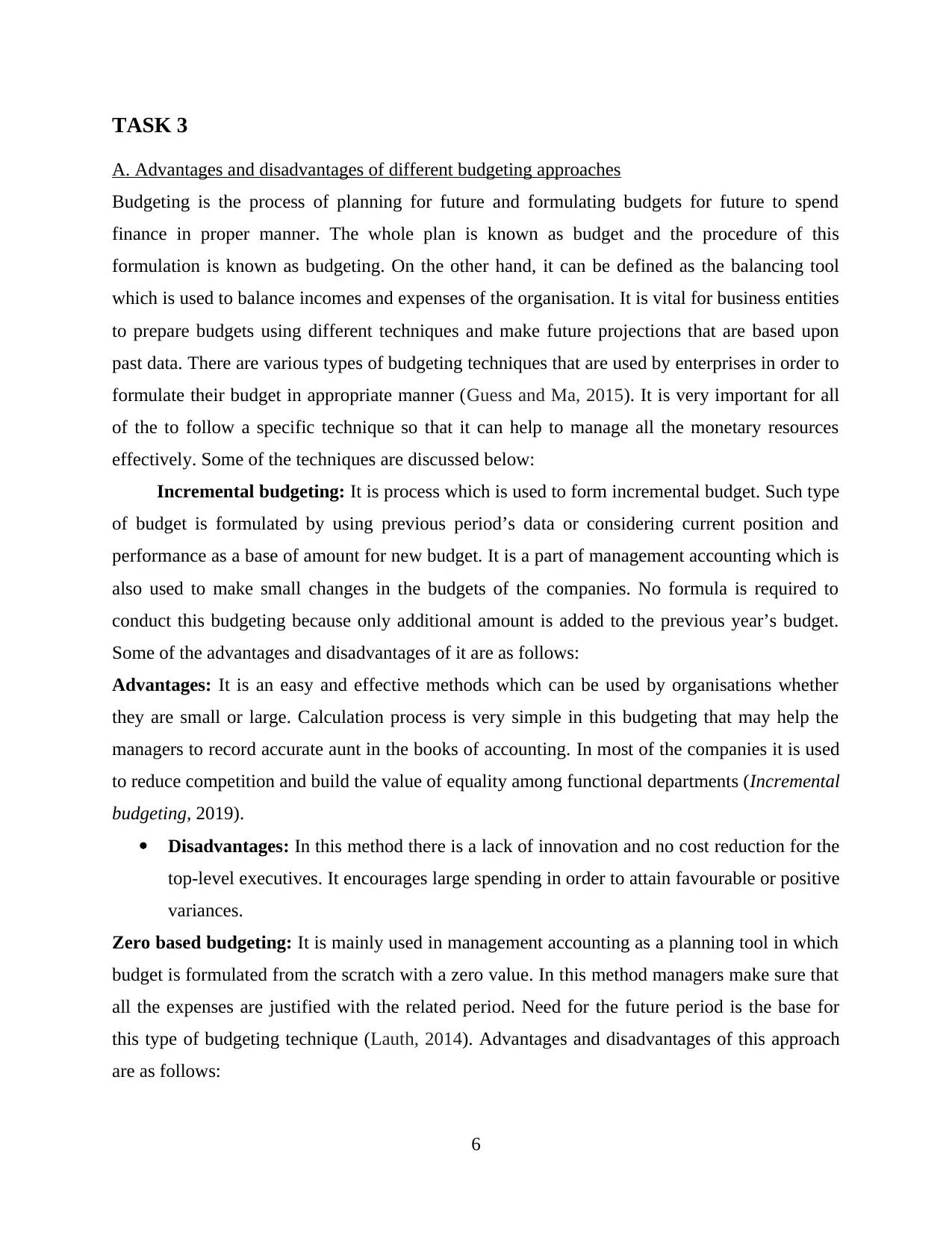
TASK 3
A. Advantages and disadvantages of different budgeting approaches
Budgeting is the process of planning for future and formulating budgets for future to spend
finance in proper manner. The whole plan is known as budget and the procedure of this
formulation is known as budgeting. On the other hand, it can be defined as the balancing tool
which is used to balance incomes and expenses of the organisation. It is vital for business entities
to prepare budgets using different techniques and make future projections that are based upon
past data. There are various types of budgeting techniques that are used by enterprises in order to
formulate their budget in appropriate manner (Guess and Ma, 2015). It is very important for all
of the to follow a specific technique so that it can help to manage all the monetary resources
effectively. Some of the techniques are discussed below:
Incremental budgeting: It is process which is used to form incremental budget. Such type
of budget is formulated by using previous period’s data or considering current position and
performance as a base of amount for new budget. It is a part of management accounting which is
also used to make small changes in the budgets of the companies. No formula is required to
conduct this budgeting because only additional amount is added to the previous year’s budget.
Some of the advantages and disadvantages of it are as follows:
Advantages: It is an easy and effective methods which can be used by organisations whether
they are small or large. Calculation process is very simple in this budgeting that may help the
managers to record accurate aunt in the books of accounting. In most of the companies it is used
to reduce competition and build the value of equality among functional departments (Incremental
budgeting, 2019).
Disadvantages: In this method there is a lack of innovation and no cost reduction for the
top-level executives. It encourages large spending in order to attain favourable or positive
variances.
Zero based budgeting: It is mainly used in management accounting as a planning tool in which
budget is formulated from the scratch with a zero value. In this method managers make sure that
all the expenses are justified with the related period. Need for the future period is the base for
this type of budgeting technique (Lauth, 2014). Advantages and disadvantages of this approach
are as follows:
6
A. Advantages and disadvantages of different budgeting approaches
Budgeting is the process of planning for future and formulating budgets for future to spend
finance in proper manner. The whole plan is known as budget and the procedure of this
formulation is known as budgeting. On the other hand, it can be defined as the balancing tool
which is used to balance incomes and expenses of the organisation. It is vital for business entities
to prepare budgets using different techniques and make future projections that are based upon
past data. There are various types of budgeting techniques that are used by enterprises in order to
formulate their budget in appropriate manner (Guess and Ma, 2015). It is very important for all
of the to follow a specific technique so that it can help to manage all the monetary resources
effectively. Some of the techniques are discussed below:
Incremental budgeting: It is process which is used to form incremental budget. Such type
of budget is formulated by using previous period’s data or considering current position and
performance as a base of amount for new budget. It is a part of management accounting which is
also used to make small changes in the budgets of the companies. No formula is required to
conduct this budgeting because only additional amount is added to the previous year’s budget.
Some of the advantages and disadvantages of it are as follows:
Advantages: It is an easy and effective methods which can be used by organisations whether
they are small or large. Calculation process is very simple in this budgeting that may help the
managers to record accurate aunt in the books of accounting. In most of the companies it is used
to reduce competition and build the value of equality among functional departments (Incremental
budgeting, 2019).
Disadvantages: In this method there is a lack of innovation and no cost reduction for the
top-level executives. It encourages large spending in order to attain favourable or positive
variances.
Zero based budgeting: It is mainly used in management accounting as a planning tool in which
budget is formulated from the scratch with a zero value. In this method managers make sure that
all the expenses are justified with the related period. Need for the future period is the base for
this type of budgeting technique (Lauth, 2014). Advantages and disadvantages of this approach
are as follows:
6
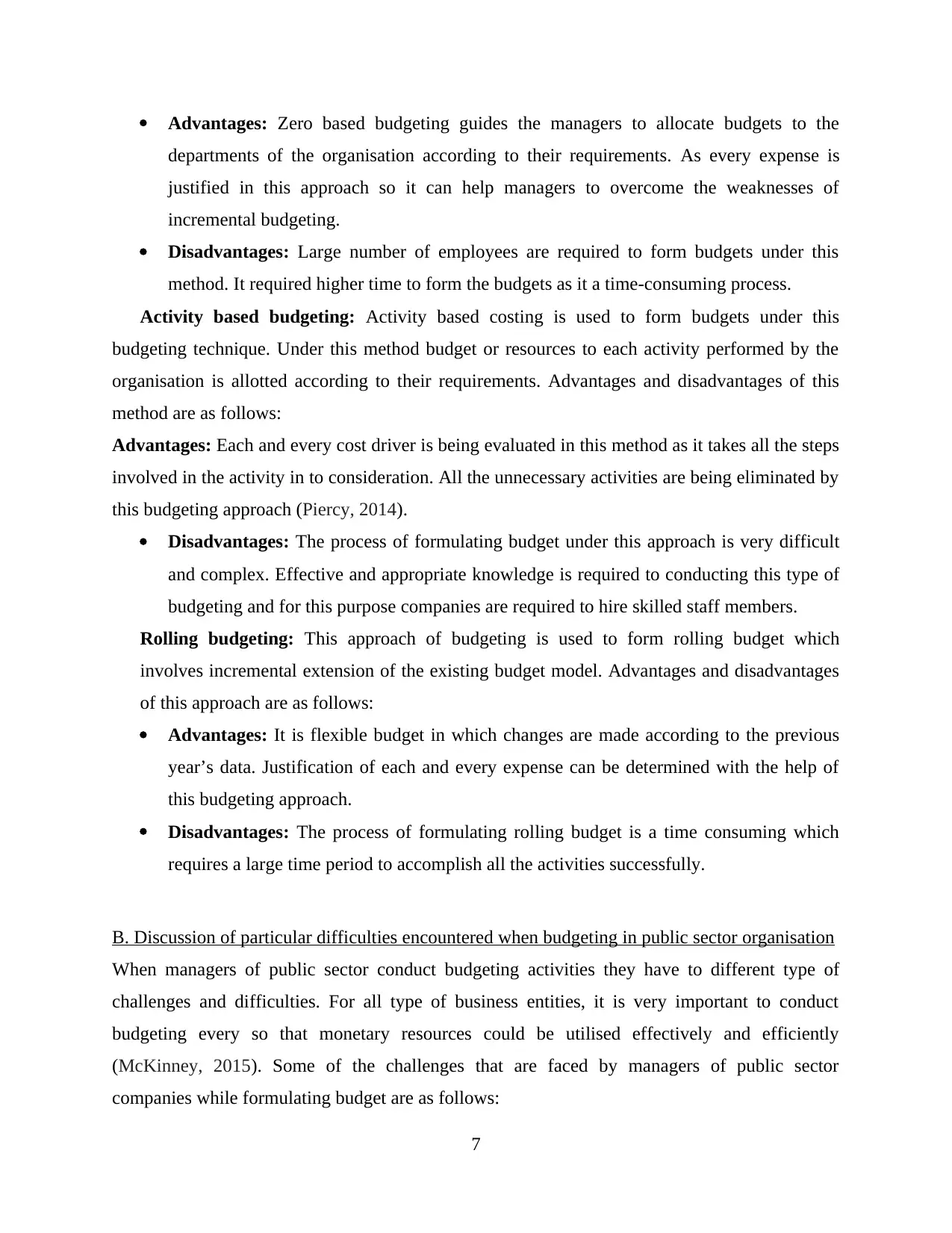
Advantages: Zero based budgeting guides the managers to allocate budgets to the
departments of the organisation according to their requirements. As every expense is
justified in this approach so it can help managers to overcome the weaknesses of
incremental budgeting.
Disadvantages: Large number of employees are required to form budgets under this
method. It required higher time to form the budgets as it a time-consuming process.
Activity based budgeting: Activity based costing is used to form budgets under this
budgeting technique. Under this method budget or resources to each activity performed by the
organisation is allotted according to their requirements. Advantages and disadvantages of this
method are as follows:
Advantages: Each and every cost driver is being evaluated in this method as it takes all the steps
involved in the activity in to consideration. All the unnecessary activities are being eliminated by
this budgeting approach (Piercy, 2014).
Disadvantages: The process of formulating budget under this approach is very difficult
and complex. Effective and appropriate knowledge is required to conducting this type of
budgeting and for this purpose companies are required to hire skilled staff members.
Rolling budgeting: This approach of budgeting is used to form rolling budget which
involves incremental extension of the existing budget model. Advantages and disadvantages
of this approach are as follows:
Advantages: It is flexible budget in which changes are made according to the previous
year’s data. Justification of each and every expense can be determined with the help of
this budgeting approach.
Disadvantages: The process of formulating rolling budget is a time consuming which
requires a large time period to accomplish all the activities successfully.
B. Discussion of particular difficulties encountered when budgeting in public sector organisation
When managers of public sector conduct budgeting activities they have to different type of
challenges and difficulties. For all type of business entities, it is very important to conduct
budgeting every so that monetary resources could be utilised effectively and efficiently
(McKinney, 2015). Some of the challenges that are faced by managers of public sector
companies while formulating budget are as follows:
7
departments of the organisation according to their requirements. As every expense is
justified in this approach so it can help managers to overcome the weaknesses of
incremental budgeting.
Disadvantages: Large number of employees are required to form budgets under this
method. It required higher time to form the budgets as it a time-consuming process.
Activity based budgeting: Activity based costing is used to form budgets under this
budgeting technique. Under this method budget or resources to each activity performed by the
organisation is allotted according to their requirements. Advantages and disadvantages of this
method are as follows:
Advantages: Each and every cost driver is being evaluated in this method as it takes all the steps
involved in the activity in to consideration. All the unnecessary activities are being eliminated by
this budgeting approach (Piercy, 2014).
Disadvantages: The process of formulating budget under this approach is very difficult
and complex. Effective and appropriate knowledge is required to conducting this type of
budgeting and for this purpose companies are required to hire skilled staff members.
Rolling budgeting: This approach of budgeting is used to form rolling budget which
involves incremental extension of the existing budget model. Advantages and disadvantages
of this approach are as follows:
Advantages: It is flexible budget in which changes are made according to the previous
year’s data. Justification of each and every expense can be determined with the help of
this budgeting approach.
Disadvantages: The process of formulating rolling budget is a time consuming which
requires a large time period to accomplish all the activities successfully.
B. Discussion of particular difficulties encountered when budgeting in public sector organisation
When managers of public sector conduct budgeting activities they have to different type of
challenges and difficulties. For all type of business entities, it is very important to conduct
budgeting every so that monetary resources could be utilised effectively and efficiently
(McKinney, 2015). Some of the challenges that are faced by managers of public sector
companies while formulating budget are as follows:
7
Secure Best Marks with AI Grader
Need help grading? Try our AI Grader for instant feedback on your assignments.
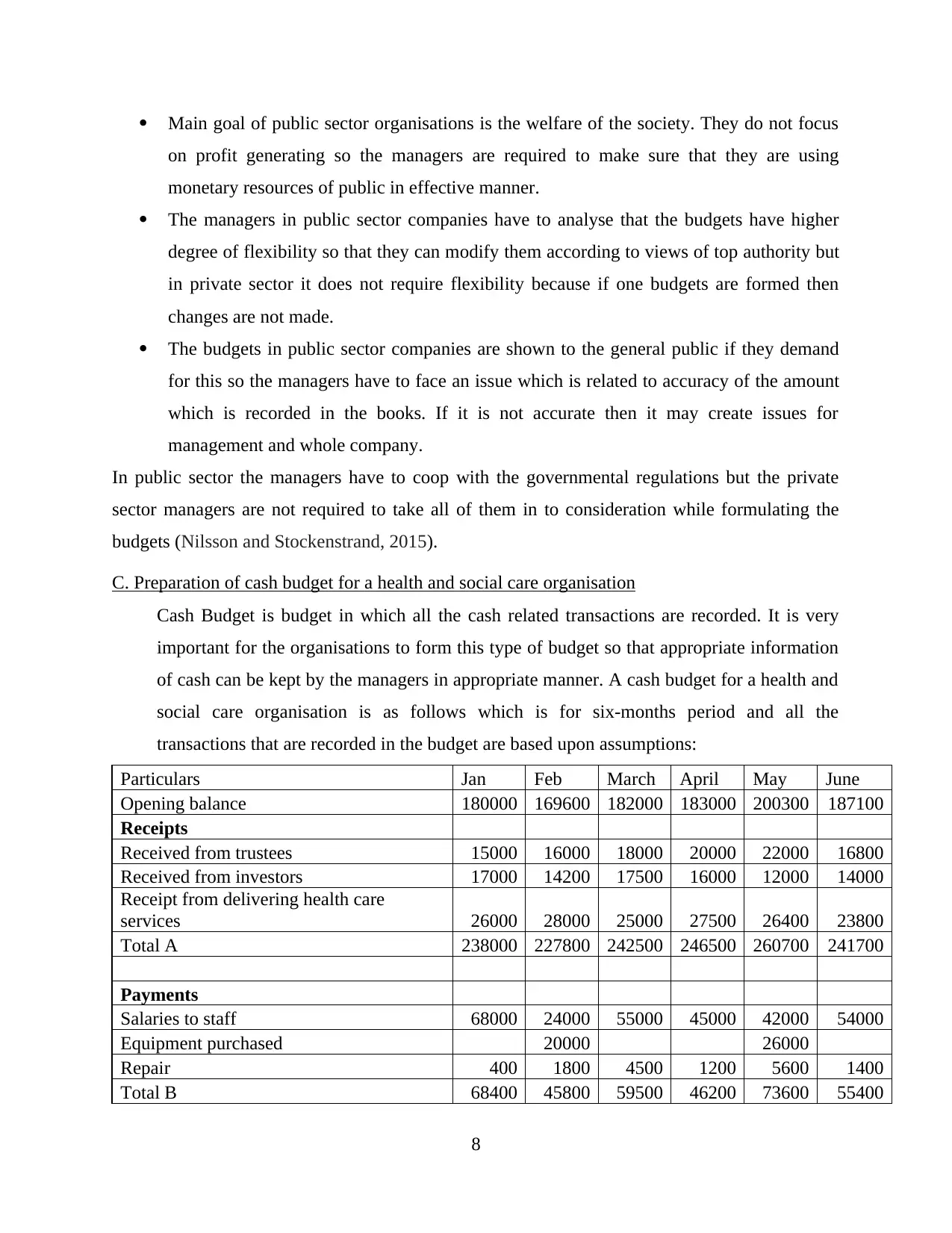
Main goal of public sector organisations is the welfare of the society. They do not focus
on profit generating so the managers are required to make sure that they are using
monetary resources of public in effective manner.
The managers in public sector companies have to analyse that the budgets have higher
degree of flexibility so that they can modify them according to views of top authority but
in private sector it does not require flexibility because if one budgets are formed then
changes are not made.
The budgets in public sector companies are shown to the general public if they demand
for this so the managers have to face an issue which is related to accuracy of the amount
which is recorded in the books. If it is not accurate then it may create issues for
management and whole company.
In public sector the managers have to coop with the governmental regulations but the private
sector managers are not required to take all of them in to consideration while formulating the
budgets (Nilsson and Stockenstrand, 2015).
C. Preparation of cash budget for a health and social care organisation
Cash Budget is budget in which all the cash related transactions are recorded. It is very
important for the organisations to form this type of budget so that appropriate information
of cash can be kept by the managers in appropriate manner. A cash budget for a health and
social care organisation is as follows which is for six-months period and all the
transactions that are recorded in the budget are based upon assumptions:
Particulars Jan Feb March April May June
Opening balance 180000 169600 182000 183000 200300 187100
Receipts
Received from trustees 15000 16000 18000 20000 22000 16800
Received from investors 17000 14200 17500 16000 12000 14000
Receipt from delivering health care
services 26000 28000 25000 27500 26400 23800
Total A 238000 227800 242500 246500 260700 241700
Payments
Salaries to staff 68000 24000 55000 45000 42000 54000
Equipment purchased 20000 26000
Repair 400 1800 4500 1200 5600 1400
Total B 68400 45800 59500 46200 73600 55400
8
on profit generating so the managers are required to make sure that they are using
monetary resources of public in effective manner.
The managers in public sector companies have to analyse that the budgets have higher
degree of flexibility so that they can modify them according to views of top authority but
in private sector it does not require flexibility because if one budgets are formed then
changes are not made.
The budgets in public sector companies are shown to the general public if they demand
for this so the managers have to face an issue which is related to accuracy of the amount
which is recorded in the books. If it is not accurate then it may create issues for
management and whole company.
In public sector the managers have to coop with the governmental regulations but the private
sector managers are not required to take all of them in to consideration while formulating the
budgets (Nilsson and Stockenstrand, 2015).
C. Preparation of cash budget for a health and social care organisation
Cash Budget is budget in which all the cash related transactions are recorded. It is very
important for the organisations to form this type of budget so that appropriate information
of cash can be kept by the managers in appropriate manner. A cash budget for a health and
social care organisation is as follows which is for six-months period and all the
transactions that are recorded in the budget are based upon assumptions:
Particulars Jan Feb March April May June
Opening balance 180000 169600 182000 183000 200300 187100
Receipts
Received from trustees 15000 16000 18000 20000 22000 16800
Received from investors 17000 14200 17500 16000 12000 14000
Receipt from delivering health care
services 26000 28000 25000 27500 26400 23800
Total A 238000 227800 242500 246500 260700 241700
Payments
Salaries to staff 68000 24000 55000 45000 42000 54000
Equipment purchased 20000 26000
Repair 400 1800 4500 1200 5600 1400
Total B 68400 45800 59500 46200 73600 55400
8
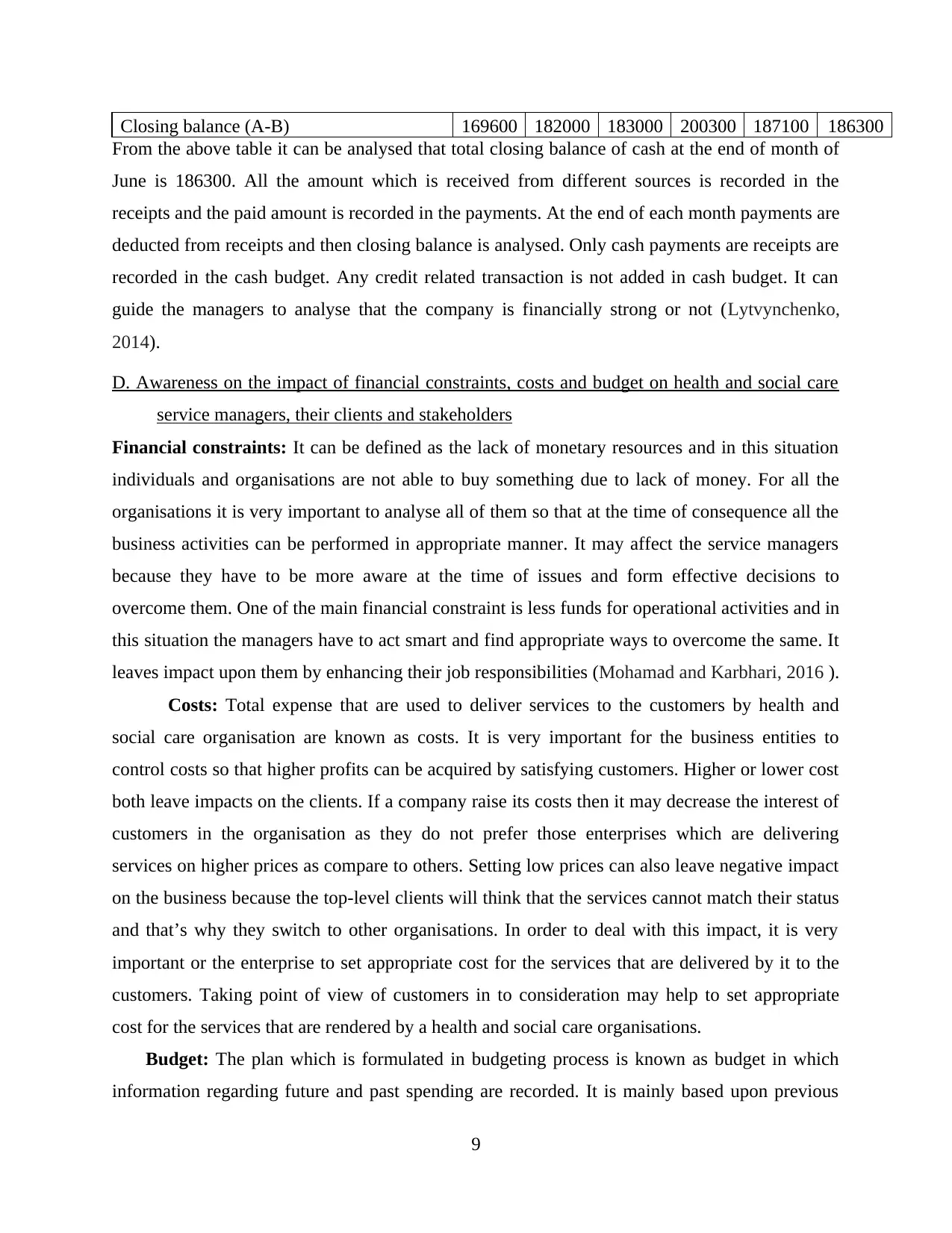
Closing balance (A-B) 169600 182000 183000 200300 187100 186300
From the above table it can be analysed that total closing balance of cash at the end of month of
June is 186300. All the amount which is received from different sources is recorded in the
receipts and the paid amount is recorded in the payments. At the end of each month payments are
deducted from receipts and then closing balance is analysed. Only cash payments are receipts are
recorded in the cash budget. Any credit related transaction is not added in cash budget. It can
guide the managers to analyse that the company is financially strong or not (Lytvynchenko,
2014).
D. Awareness on the impact of financial constraints, costs and budget on health and social care
service managers, their clients and stakeholders
Financial constraints: It can be defined as the lack of monetary resources and in this situation
individuals and organisations are not able to buy something due to lack of money. For all the
organisations it is very important to analyse all of them so that at the time of consequence all the
business activities can be performed in appropriate manner. It may affect the service managers
because they have to be more aware at the time of issues and form effective decisions to
overcome them. One of the main financial constraint is less funds for operational activities and in
this situation the managers have to act smart and find appropriate ways to overcome the same. It
leaves impact upon them by enhancing their job responsibilities (Mohamad and Karbhari, 2016 ).
Costs: Total expense that are used to deliver services to the customers by health and
social care organisation are known as costs. It is very important for the business entities to
control costs so that higher profits can be acquired by satisfying customers. Higher or lower cost
both leave impacts on the clients. If a company raise its costs then it may decrease the interest of
customers in the organisation as they do not prefer those enterprises which are delivering
services on higher prices as compare to others. Setting low prices can also leave negative impact
on the business because the top-level clients will think that the services cannot match their status
and that’s why they switch to other organisations. In order to deal with this impact, it is very
important or the enterprise to set appropriate cost for the services that are delivered by it to the
customers. Taking point of view of customers in to consideration may help to set appropriate
cost for the services that are rendered by a health and social care organisations.
Budget: The plan which is formulated in budgeting process is known as budget in which
information regarding future and past spending are recorded. It is mainly based upon previous
9
From the above table it can be analysed that total closing balance of cash at the end of month of
June is 186300. All the amount which is received from different sources is recorded in the
receipts and the paid amount is recorded in the payments. At the end of each month payments are
deducted from receipts and then closing balance is analysed. Only cash payments are receipts are
recorded in the cash budget. Any credit related transaction is not added in cash budget. It can
guide the managers to analyse that the company is financially strong or not (Lytvynchenko,
2014).
D. Awareness on the impact of financial constraints, costs and budget on health and social care
service managers, their clients and stakeholders
Financial constraints: It can be defined as the lack of monetary resources and in this situation
individuals and organisations are not able to buy something due to lack of money. For all the
organisations it is very important to analyse all of them so that at the time of consequence all the
business activities can be performed in appropriate manner. It may affect the service managers
because they have to be more aware at the time of issues and form effective decisions to
overcome them. One of the main financial constraint is less funds for operational activities and in
this situation the managers have to act smart and find appropriate ways to overcome the same. It
leaves impact upon them by enhancing their job responsibilities (Mohamad and Karbhari, 2016 ).
Costs: Total expense that are used to deliver services to the customers by health and
social care organisation are known as costs. It is very important for the business entities to
control costs so that higher profits can be acquired by satisfying customers. Higher or lower cost
both leave impacts on the clients. If a company raise its costs then it may decrease the interest of
customers in the organisation as they do not prefer those enterprises which are delivering
services on higher prices as compare to others. Setting low prices can also leave negative impact
on the business because the top-level clients will think that the services cannot match their status
and that’s why they switch to other organisations. In order to deal with this impact, it is very
important or the enterprise to set appropriate cost for the services that are delivered by it to the
customers. Taking point of view of customers in to consideration may help to set appropriate
cost for the services that are rendered by a health and social care organisations.
Budget: The plan which is formulated in budgeting process is known as budget in which
information regarding future and past spending are recorded. It is mainly based upon previous
9
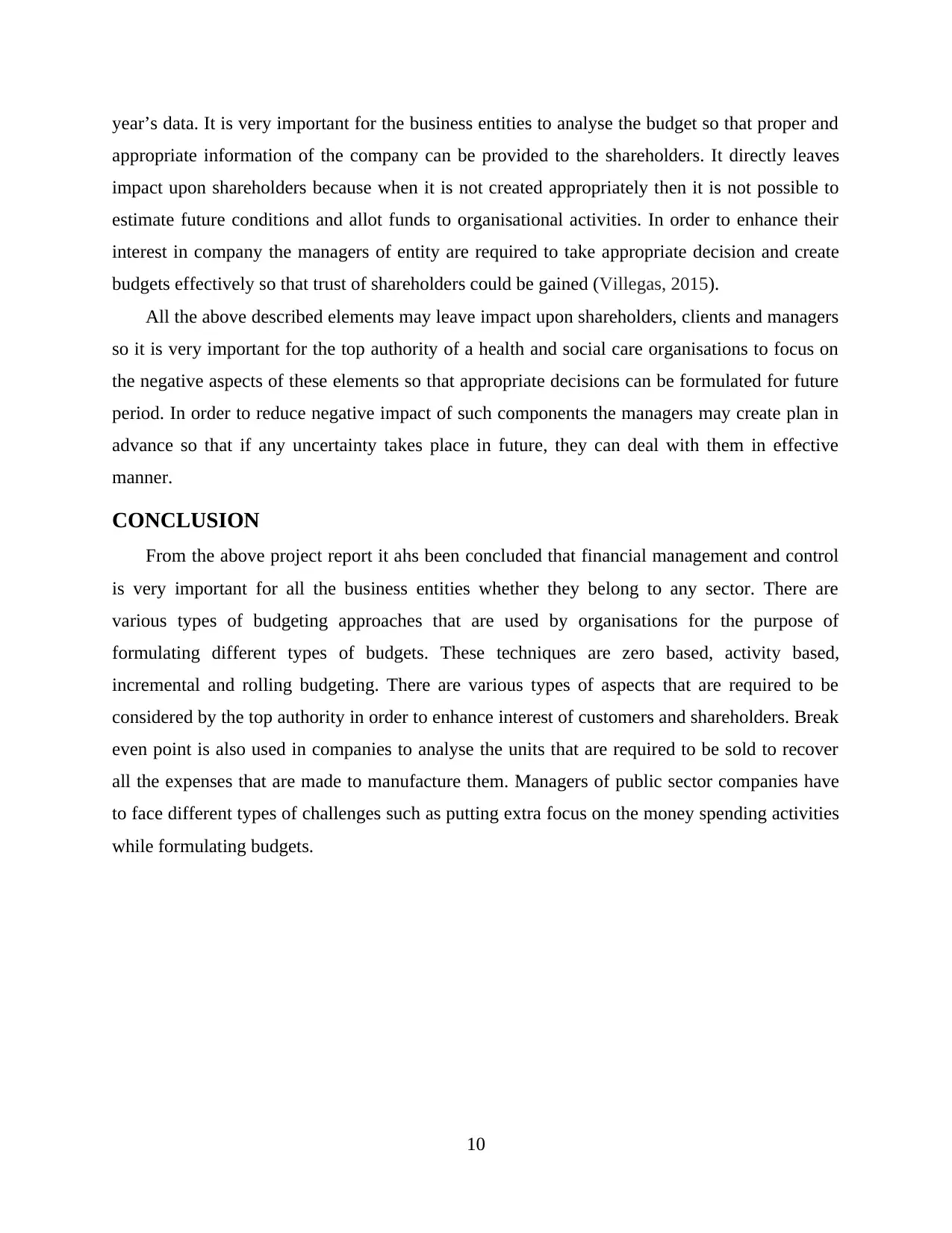
year’s data. It is very important for the business entities to analyse the budget so that proper and
appropriate information of the company can be provided to the shareholders. It directly leaves
impact upon shareholders because when it is not created appropriately then it is not possible to
estimate future conditions and allot funds to organisational activities. In order to enhance their
interest in company the managers of entity are required to take appropriate decision and create
budgets effectively so that trust of shareholders could be gained (Villegas, 2015).
All the above described elements may leave impact upon shareholders, clients and managers
so it is very important for the top authority of a health and social care organisations to focus on
the negative aspects of these elements so that appropriate decisions can be formulated for future
period. In order to reduce negative impact of such components the managers may create plan in
advance so that if any uncertainty takes place in future, they can deal with them in effective
manner.
CONCLUSION
From the above project report it ahs been concluded that financial management and control
is very important for all the business entities whether they belong to any sector. There are
various types of budgeting approaches that are used by organisations for the purpose of
formulating different types of budgets. These techniques are zero based, activity based,
incremental and rolling budgeting. There are various types of aspects that are required to be
considered by the top authority in order to enhance interest of customers and shareholders. Break
even point is also used in companies to analyse the units that are required to be sold to recover
all the expenses that are made to manufacture them. Managers of public sector companies have
to face different types of challenges such as putting extra focus on the money spending activities
while formulating budgets.
10
appropriate information of the company can be provided to the shareholders. It directly leaves
impact upon shareholders because when it is not created appropriately then it is not possible to
estimate future conditions and allot funds to organisational activities. In order to enhance their
interest in company the managers of entity are required to take appropriate decision and create
budgets effectively so that trust of shareholders could be gained (Villegas, 2015).
All the above described elements may leave impact upon shareholders, clients and managers
so it is very important for the top authority of a health and social care organisations to focus on
the negative aspects of these elements so that appropriate decisions can be formulated for future
period. In order to reduce negative impact of such components the managers may create plan in
advance so that if any uncertainty takes place in future, they can deal with them in effective
manner.
CONCLUSION
From the above project report it ahs been concluded that financial management and control
is very important for all the business entities whether they belong to any sector. There are
various types of budgeting approaches that are used by organisations for the purpose of
formulating different types of budgets. These techniques are zero based, activity based,
incremental and rolling budgeting. There are various types of aspects that are required to be
considered by the top authority in order to enhance interest of customers and shareholders. Break
even point is also used in companies to analyse the units that are required to be sold to recover
all the expenses that are made to manufacture them. Managers of public sector companies have
to face different types of challenges such as putting extra focus on the money spending activities
while formulating budgets.
10
Paraphrase This Document
Need a fresh take? Get an instant paraphrase of this document with our AI Paraphraser
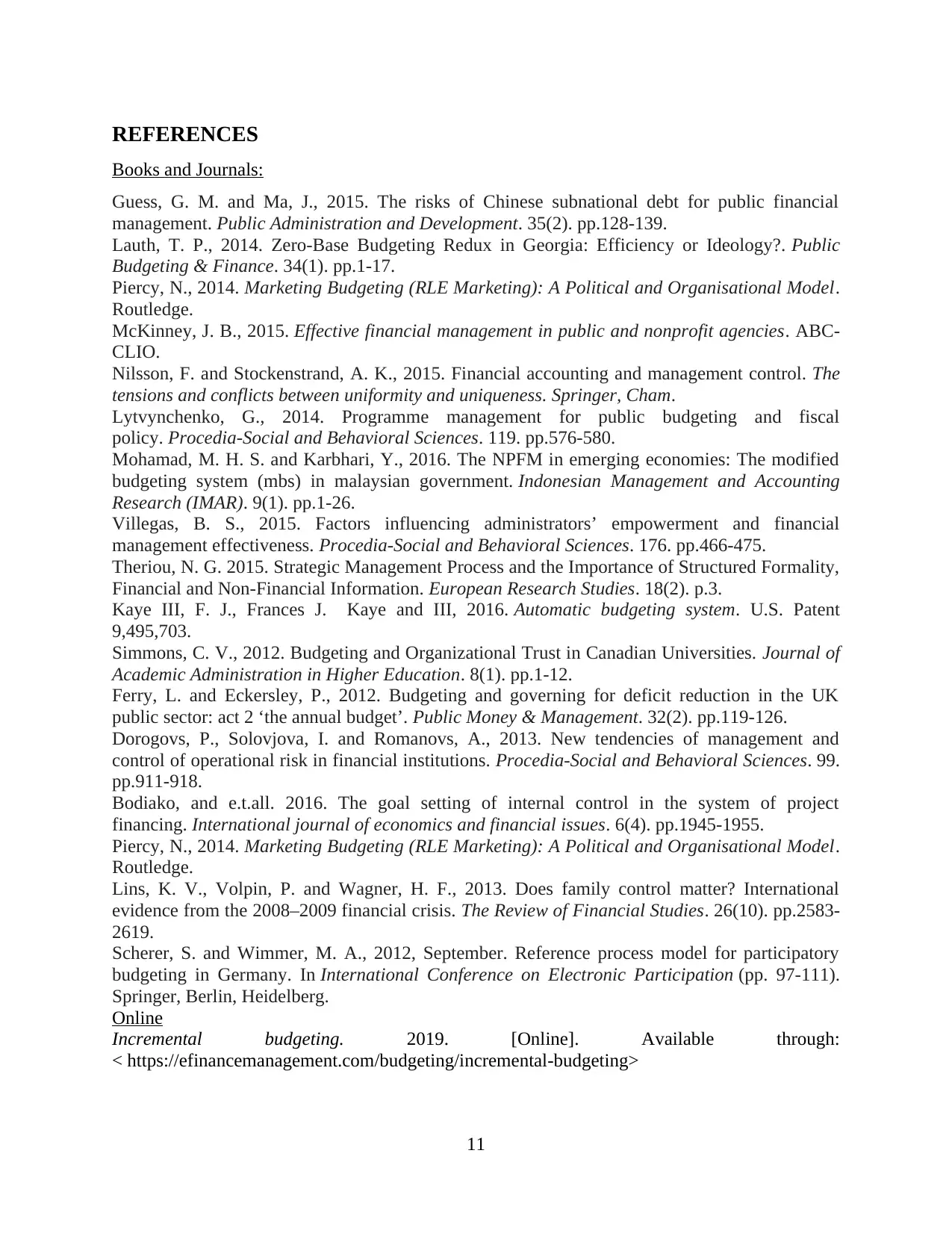
REFERENCES
Books and Journals:
Guess, G. M. and Ma, J., 2015. The risks of Chinese subnational debt for public financial
management. Public Administration and Development. 35(2). pp.128-139.
Lauth, T. P., 2014. Zero‐Base Budgeting Redux in Georgia: Efficiency or Ideology?. Public
Budgeting & Finance. 34(1). pp.1-17.
Piercy, N., 2014. Marketing Budgeting (RLE Marketing): A Political and Organisational Model.
Routledge.
McKinney, J. B., 2015. Effective financial management in public and nonprofit agencies. ABC-
CLIO.
Nilsson, F. and Stockenstrand, A. K., 2015. Financial accounting and management control. The
tensions and conflicts between uniformity and uniqueness. Springer, Cham.
Lytvynchenko, G., 2014. Programme management for public budgeting and fiscal
policy. Procedia-Social and Behavioral Sciences. 119. pp.576-580.
Mohamad, M. H. S. and Karbhari, Y., 2016. The NPFM in emerging economies: The modified
budgeting system (mbs) in malaysian government. Indonesian Management and Accounting
Research (IMAR). 9(1). pp.1-26.
Villegas, B. S., 2015. Factors influencing administrators’ empowerment and financial
management effectiveness. Procedia-Social and Behavioral Sciences. 176. pp.466-475.
Theriou, N. G. 2015. Strategic Management Process and the Importance of Structured Formality,
Financial and Non-Financial Information. European Research Studies. 18(2). p.3.
Kaye III, F. J., Frances J. Kaye and III, 2016. Automatic budgeting system. U.S. Patent
9,495,703.
Simmons, C. V., 2012. Budgeting and Organizational Trust in Canadian Universities. Journal of
Academic Administration in Higher Education. 8(1). pp.1-12.
Ferry, L. and Eckersley, P., 2012. Budgeting and governing for deficit reduction in the UK
public sector: act 2 ‘the annual budget’. Public Money & Management. 32(2). pp.119-126.
Dorogovs, P., Solovjova, I. and Romanovs, A., 2013. New tendencies of management and
control of operational risk in financial institutions. Procedia-Social and Behavioral Sciences. 99.
pp.911-918.
Bodiako, and e.t.all. 2016. The goal setting of internal control in the system of project
financing. International journal of economics and financial issues. 6(4). pp.1945-1955.
Piercy, N., 2014. Marketing Budgeting (RLE Marketing): A Political and Organisational Model.
Routledge.
Lins, K. V., Volpin, P. and Wagner, H. F., 2013. Does family control matter? International
evidence from the 2008–2009 financial crisis. The Review of Financial Studies. 26(10). pp.2583-
2619.
Scherer, S. and Wimmer, M. A., 2012, September. Reference process model for participatory
budgeting in Germany. In International Conference on Electronic Participation (pp. 97-111).
Springer, Berlin, Heidelberg.
Online
Incremental budgeting. 2019. [Online]. Available through:
< https://efinancemanagement.com/budgeting/incremental-budgeting>
11
Books and Journals:
Guess, G. M. and Ma, J., 2015. The risks of Chinese subnational debt for public financial
management. Public Administration and Development. 35(2). pp.128-139.
Lauth, T. P., 2014. Zero‐Base Budgeting Redux in Georgia: Efficiency or Ideology?. Public
Budgeting & Finance. 34(1). pp.1-17.
Piercy, N., 2014. Marketing Budgeting (RLE Marketing): A Political and Organisational Model.
Routledge.
McKinney, J. B., 2015. Effective financial management in public and nonprofit agencies. ABC-
CLIO.
Nilsson, F. and Stockenstrand, A. K., 2015. Financial accounting and management control. The
tensions and conflicts between uniformity and uniqueness. Springer, Cham.
Lytvynchenko, G., 2014. Programme management for public budgeting and fiscal
policy. Procedia-Social and Behavioral Sciences. 119. pp.576-580.
Mohamad, M. H. S. and Karbhari, Y., 2016. The NPFM in emerging economies: The modified
budgeting system (mbs) in malaysian government. Indonesian Management and Accounting
Research (IMAR). 9(1). pp.1-26.
Villegas, B. S., 2015. Factors influencing administrators’ empowerment and financial
management effectiveness. Procedia-Social and Behavioral Sciences. 176. pp.466-475.
Theriou, N. G. 2015. Strategic Management Process and the Importance of Structured Formality,
Financial and Non-Financial Information. European Research Studies. 18(2). p.3.
Kaye III, F. J., Frances J. Kaye and III, 2016. Automatic budgeting system. U.S. Patent
9,495,703.
Simmons, C. V., 2012. Budgeting and Organizational Trust in Canadian Universities. Journal of
Academic Administration in Higher Education. 8(1). pp.1-12.
Ferry, L. and Eckersley, P., 2012. Budgeting and governing for deficit reduction in the UK
public sector: act 2 ‘the annual budget’. Public Money & Management. 32(2). pp.119-126.
Dorogovs, P., Solovjova, I. and Romanovs, A., 2013. New tendencies of management and
control of operational risk in financial institutions. Procedia-Social and Behavioral Sciences. 99.
pp.911-918.
Bodiako, and e.t.all. 2016. The goal setting of internal control in the system of project
financing. International journal of economics and financial issues. 6(4). pp.1945-1955.
Piercy, N., 2014. Marketing Budgeting (RLE Marketing): A Political and Organisational Model.
Routledge.
Lins, K. V., Volpin, P. and Wagner, H. F., 2013. Does family control matter? International
evidence from the 2008–2009 financial crisis. The Review of Financial Studies. 26(10). pp.2583-
2619.
Scherer, S. and Wimmer, M. A., 2012, September. Reference process model for participatory
budgeting in Germany. In International Conference on Electronic Participation (pp. 97-111).
Springer, Berlin, Heidelberg.
Online
Incremental budgeting. 2019. [Online]. Available through:
< https://efinancemanagement.com/budgeting/incremental-budgeting>
11
1 out of 14
Related Documents
Your All-in-One AI-Powered Toolkit for Academic Success.
+13062052269
info@desklib.com
Available 24*7 on WhatsApp / Email
![[object Object]](/_next/static/media/star-bottom.7253800d.svg)
Unlock your academic potential
© 2024 | Zucol Services PVT LTD | All rights reserved.



